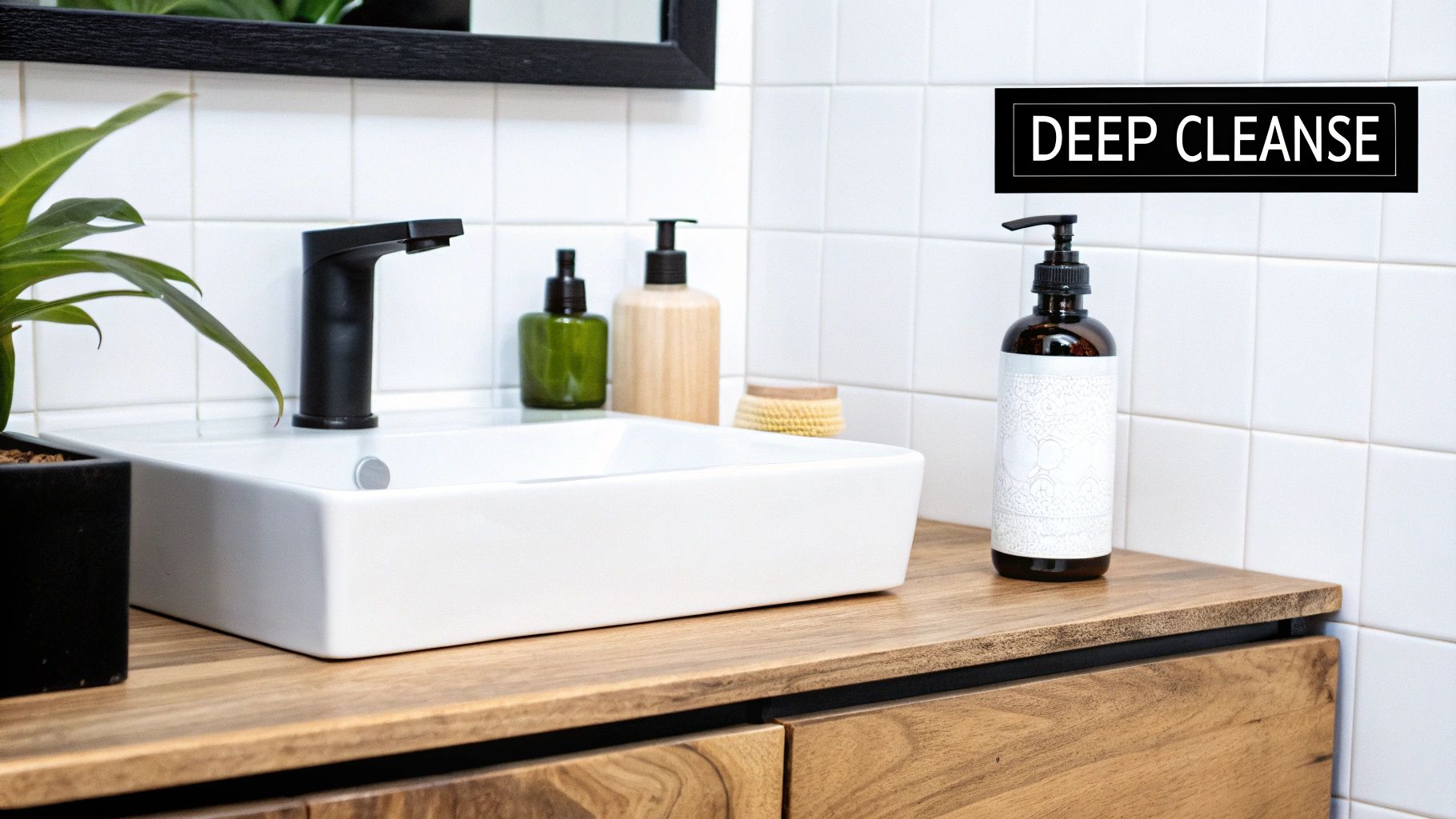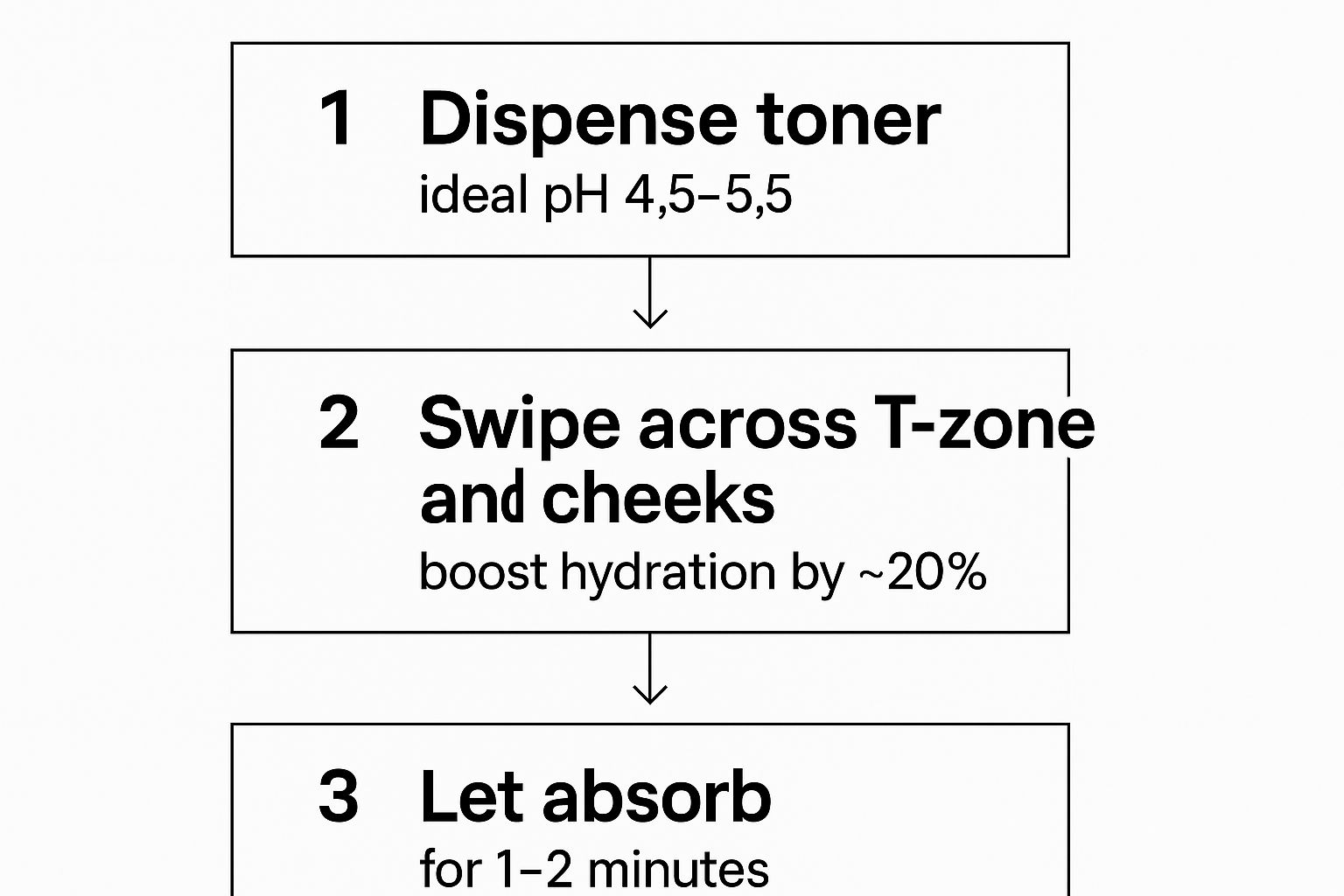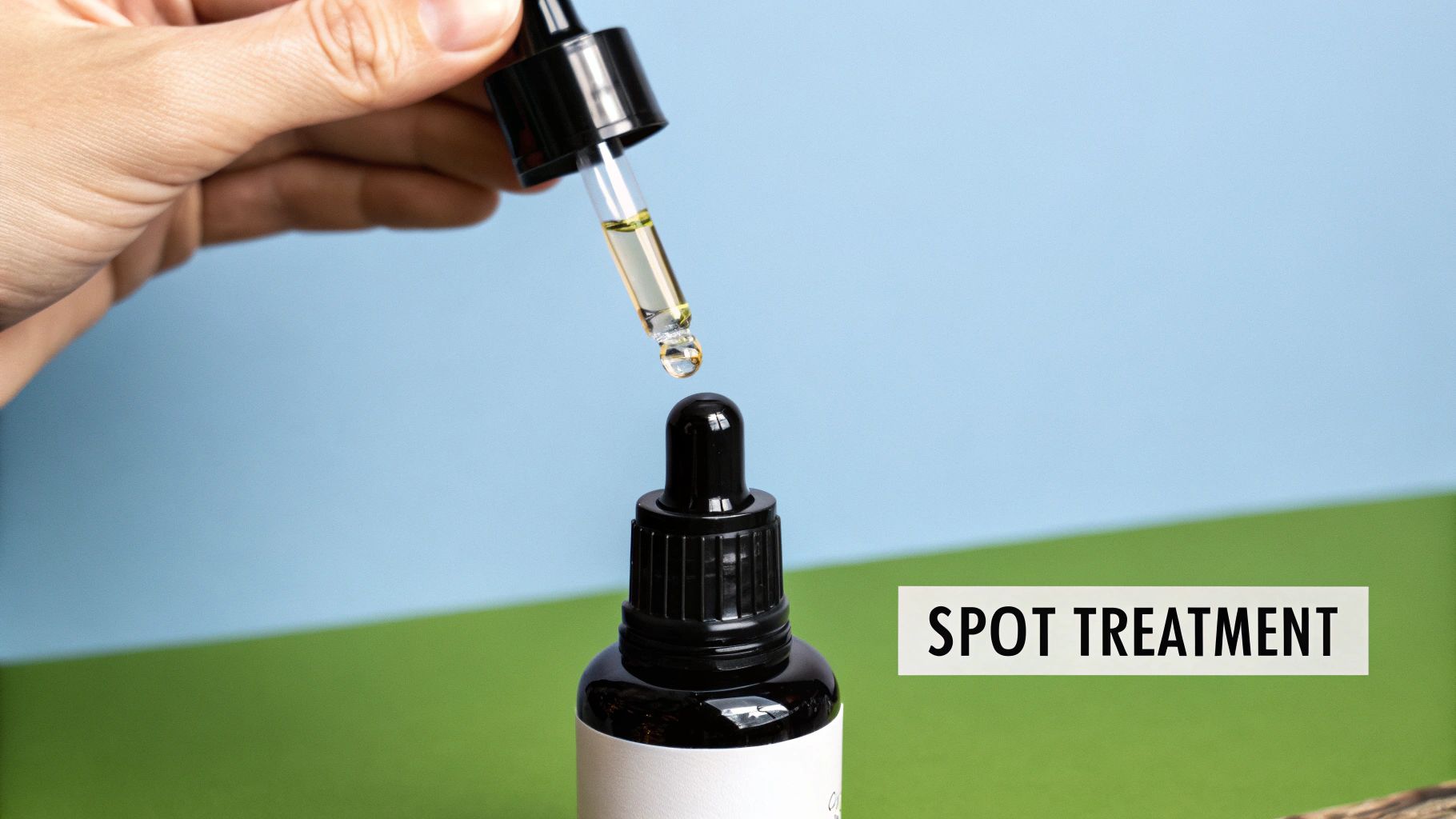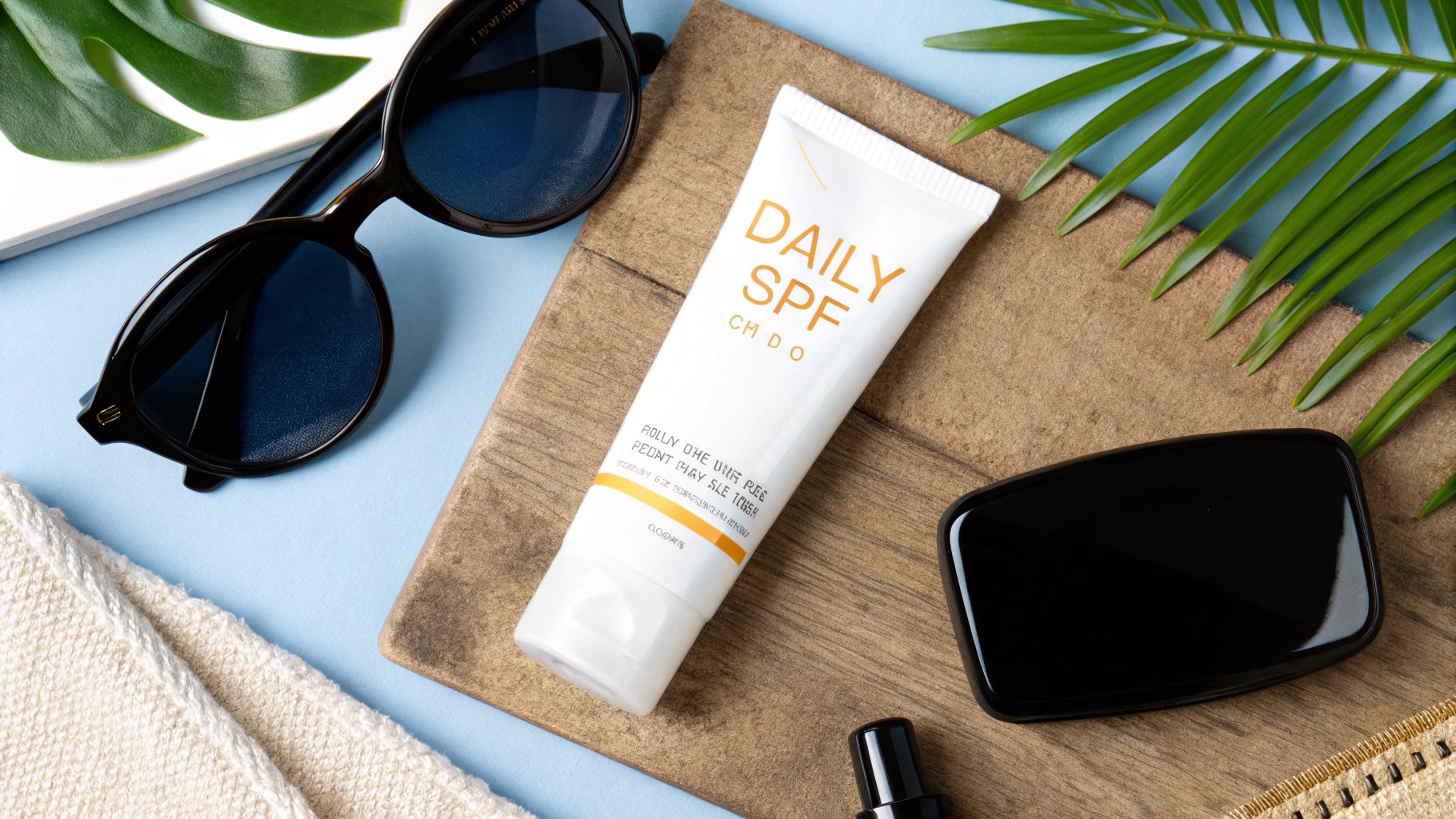Essential Skincare Routine for Combination Skin: A Canadian's Guide
- Blog Admin

- 7 hours ago
- 14 min read
If your skin feels like it has a split personality—oily in some spots while frustratingly dry or tight in others—you're not alone. Welcome to the world of combination skin. The real secret to caring for it isn't about fighting a war on two fronts, but creating a sense of balance. It all comes down to using the right products that can manage oil without robbing your drier areas of precious moisture.
Getting to Know Your Combination Skin
We’ve all heard the classic "oily T-zone, dry cheeks" description, but let's be honest, it's usually a lot more complicated than that. Combination skin is its own distinct type, defined by having both oily and dry (or even normal) patches on your face at the same time. This happens because the oil glands, or sebaceous glands, aren't evenly distributed. Your forehead, nose, and chin naturally have more of them, and they're often more active, which leads to that telltale shine and more noticeable pores.
Meanwhile, your cheeks and jawline often have fewer oil glands. This makes them susceptible to dryness, flakiness, or that tight, uncomfortable feeling, especially right after you wash your face. This split is mostly down to genetics, but a few other culprits can definitely make things worse.
So, What Causes This Imbalance?
Understanding what’s really going on with your skin is the first step to building a routine that actually works. While you can thank your parents for the genetic blueprint, your skin's day-to-day behaviour is shaped by a lot more.
A few key factors are often at play:
Hormonal Fluctuations: Any shift in your hormones can kick sebum production into high gear, making your T-zone look extra slick.
Environmental Stressors: Here in Canada, this is a big one. That swing from harsh, dry winter air to sticky summer humidity can throw your skin for a loop, making both the oily and dry patches more extreme.
The Wrong Skincare Products: This is a mistake I see all the time. Using harsh, stripping cleansers wreaks havoc on your skin's natural moisture barrier. When that barrier is damaged, your dry areas get even drier, and your oily zones might actually produce more oil to try and compensate.
One of the most common missteps is slathering the entire face with products meant for oily skin. This can seriously dehydrate your cheeks and jawline, triggering irritation and a weakened skin barrier.
Mapping Out Your Skin's Unique Pattern
The goal here is to get personal. Forget a one-size-fits-all approach and start listening to what your skin is telling you. A great way to do this is to simply watch your skin for an hour after cleansing (with no products on). Take note of where shine starts to pop up first and which areas feel tight or look a little flaky.
This simple observation helps you map out your unique combination pattern. Knowing this is crucial for creating a personalized routine. Properly protecting these different zones often means starting with your skin's first line of defence. You can learn more about how to do just that in our guide to skin barrier repair for healthy Canadian skin.
Crafting Your Morning Protection Routine

Your morning skincare routine doesn't need to be a complicated, ten-step affair. It's really about two simple things: getting your skin balanced for the day and protecting it from everything the world throws at it. For those of us with combination skin, this just means waking it up gently without sending it into chaos.
Think of it like setting a calm, stable foundation. You want to control the oily areas without drying out the other parts, creating a balanced canvas that’s ready for makeup, pollution, and anything else your day has in store.
Start With a Gentle Cleanse
When you wake up with an oily T-zone, it's so tempting to grab the strongest, foamiest cleanser you can find and scrub it all away. I see this all the time, and it almost always backfires. You end up stripping your skin's natural moisture barrier, which just tells your oil glands to work overtime to make up for it.
Instead, reach for a mild, pH-balanced gel or milky cleanser. The real goal here is just to refresh your skin and wash off any leftover nighttime products, not to leave it feeling tight and "squeaky clean." A gentle touch cleans your T-zone perfectly while being kind to your drier cheeks.
Tone to Hydrate and Balance
Let's forget about the old-school, alcohol-heavy toners that used to sting and dry everything out. Today’s toners are all about hydrating and rebalancing your skin's pH right after you cleanse. You want to look for alcohol-free formulas that have hydrating heroes like hyaluronic acid or glycerin.
Here’s a little tip: apply your toner to damp skin. It helps it sink in better and really preps your face for the next products in your routine. It's such a simple step but it makes a big difference in adding moisture right where you need it.
The Power of a Targeted Serum
This is where you can get really specific and customize your routine. A great serum delivers a concentrated punch of ingredients to tackle exactly what your combination skin needs, and for this, Niacinamide is a total superstar.
Niacinamide is a brilliant multi-tasker for combination skin. It helps regulate oil production to cut down on T-zone shine, makes pores look smaller, and has anti-inflammatory properties that calm everything down.
By using a lightweight niacinamide serum, you're directly managing the oiliness without adding heavy creams that might feel greasy or block pores on your cheeks. It just works to bring a sense of harmony to your whole face.
Don't Skip the Moisturizer
Yes, even the oily parts of your face need moisture! I can't stress this enough. Skipping moisturizer can actually dehydrate your skin, which, you guessed it, makes it produce even more oil. The trick is simply finding the right texture.
Look for a lightweight, non-comedogenic moisturizer, which is just a fancy way of saying it won’t clog your pores. Gel-creams or fluid lotions are fantastic choices because they hydrate without feeling heavy or leaving a greasy film. This way, your dry spots feel comfortable and your T-zone stays balanced.
Your Most Important Step: Sunscreen
If you only do one thing for your skin in the morning, please make it sunscreen. Sun exposure is the number one cause of premature aging and skin damage—it’s a non-negotiable for every Canadian, no matter how cloudy it looks outside. In fact, up to 80% of the visible signs of aging are caused by UV exposure, a figure relevant worldwide, including here in Canada.
For combination skin, the challenge is always finding a sunscreen that doesn't feel like a heavy, greasy mask. Keep an eye out for lightweight, oil-free formulas that are also labeled "non-comedogenic." Mineral sunscreens with zinc oxide can sometimes give a nice mattifying effect, which is a bonus for an oily T-zone.
To find the perfect fit, you can explore high-quality SPF products like those from Colorescience, which offer amazing protection without the weight. This final step is what shields your skin and completes your morning defence.
Your Evening Routine for Repair and Renewal
When the day ends, your skin's real work begins. It shifts from defending against daily grime and sun to an all-night repair session. This is its time to heal, regenerate, and get back into balance. A smart evening routine is all about supporting that natural process so you can wake up to a complexion that feels calm, comfortable, and refreshed. Think of it as a one-two punch: deep cleaning followed by targeted treatments.
Everything your skin has collected throughout the day—makeup, oil, sunscreen, and city pollutants—needs a more thorough cleanse than a quick morning wash. This is where double cleansing isn't just a trend; it's a necessity. Especially here in Canada, where we're diligent with long-wear sunscreen—whether it's for intense summer days or that surprisingly strong winter sun reflecting off the snow—a single cleanse often doesn't cut it. In fact, a proper double cleanse can get rid of impurities up to 10 times more effectively than just washing your face once.
The Art of the Double Cleanse
Your first step should always be an oil-based cleanser on dry skin. Take a moment to gently massage it in. You'll literally feel it melting away stubborn sunscreen, foundation, and the day's excess oil. The beauty of this step is that the oil cleanser latches onto these impurities without stripping the natural moisture from your drier areas, like your cheeks.
Once you rinse that off, it’s time for round two. Grab that same gentle, water-based cleanser you used in the morning (a gel or milky formula is perfect). This second wash clears away any lingering residue, leaving your skin perfectly prepped for the next steps. This method is a game-changer for combination skin because it ensures your oily T-zone is truly clean, while your cheeks stay happy and hydrated.
Targeted Treatments for Balanced Results
Now that you have a clean canvas, it's time to get strategic with your treatments. This is your chance to really customize your routine and give your skin exactly what it needs, where it needs it.
A huge mistake I see people make is slathering one strong active ingredient all over their face. With combination skin, that's a recipe for disaster. You'll likely end up with irritated, flaky cheeks while your T-zone still isn't getting the deep clean it needs. It's all about strategic placement.
Here’s a simple way to approach it:
For your T-zone (the oily bits): Reach for a Beta-Hydroxy Acid (BHA), like salicylic acid. BHAs are brilliant because they're oil-soluble, which means they can get deep into your pores to break up congestion, kick blackheads to the curb, and keep shine under control.
For your cheeks (the dry or normal bits): A gentler Alpha-Hydroxy Acid (AHA) like lactic acid is a great choice here. It exfoliates the surface to improve texture but also has hydrating properties. Alternatively, you can skip exfoliating acids on your cheeks altogether and just press in a hydrating serum with ingredients like hyaluronic acid or glycerin.

Before you jump to serums, don't forget the power of a good toner. As you can see, patting in a hydrating toner after cleansing is a crucial step. It helps rebalance your skin's pH and gives it a big drink of water, making it much more receptive to the active ingredients you're about to apply.
To help visualize how your day and night goals differ, here’s a quick breakdown:
Morning vs. Evening Routine Focus
Focus | Morning (Protect & Balance) | Evening (Cleanse & Repair) |
|---|---|---|
Primary Goal | Shield skin from UV rays & pollutants, control daytime oil. | Deep clean impurities, repair damage, and replenish moisture. |
Cleanser Type | Gentle, non-stripping gel or milky cleanser. | Two steps: Oil-based cleanser followed by a water-based cleanser. |
Treatment Focus | Antioxidants (like Vitamin C), lightweight hydration. | Exfoliating acids (AHAs/BHAs), retinoids, targeted serums. |
Moisturizer | Lightweight, oil-free, ideally with SPF. | Nourishing, barrier-supporting cream without SPF. |
This table shows how your AM routine is about setting your skin up for success during the day, while your PM routine is all about recovery and renewal.
Finish With a Nourishing Moisturizer
The final, non-negotiable step of your evening routine is sealing everything in with a good moisturizer. Your night cream can be a bit richer than your day lotion, but that doesn't mean it should feel heavy or greasy.
Look for a formula with ingredients that help rebuild your skin's protective barrier while you sleep. Ceramides, peptides, and niacinamide are all-stars here. They work overnight to repair damage, calm redness, and even help regulate oil production. The right night cream will leave your dry spots feeling soothed and nourished, while your T-zone stays balanced and comfortable—not slick.
Choosing Products That Actually Work

Walking down the skincare aisle can feel like a pop quiz you didn't study for, especially when you're dealing with skin that's both oily and dry. I've seen so many clients get frustrated. But here’s the secret: the goal isn’t to pile on more products, it’s to pick the right ones. For combination skin, the most powerful tool you have is understanding what’s inside the bottle.
Think of your face like a garden with different patches of soil. You wouldn’t put the same fertilizer on sandy soil that you’d use for rich clay, right? It's the same logic for your skin. Your T-zone and your cheeks have completely different needs. Once you get the hang of reading ingredient lists, you’ll be able to see past the flashy marketing and find formulas that actually deliver results.
This is a huge deal here in Canada, where our wild seasonal swings—from bitingly cold, dry winters to hot, humid summers—can throw combination skin for a real loop.
Your Ingredient Cheat Sheet
To get your skin balanced and happy, you want to look for multi-tasking ingredients. These are the workhorses that hydrate, balance, and protect without kicking up a fuss or causing irritation.
Hyaluronic Acid (HA): This stuff is a moisture magnet. It can hold up to 1,000 times its own weight in water, which means it delivers a serious dose of hydration without feeling greasy or heavy. It’s perfect for quenching those dry patches without making your oily zones feel slick.
Niacinamide (Vitamin B3): A true superstar for anyone with combination skin. Niacinamide is a game-changer because it helps get oil production under control, which is amazing for a shiny T-zone. On top of that, it strengthens your skin barrier and makes pores look smaller. A total win-win.
Antioxidants (like Vitamin C & E): Think of these as your skin's personal bodyguards against environmental stress. A good Vitamin C serum in the morning is fantastic for brightening up your whole complexion and protecting your skin from pollution throughout the day.
By focusing on what your skin needs—hydration for dry spots, balance for oily areas—you can create a simple yet powerful routine. More isn't always better; effective is what counts.
What to Steer Clear Of
Knowing what to use is only half the battle. Knowing what to avoid is just as important. Some ingredients can throw your skin’s delicate balance out of whack, leaving your dry spots drier and your oily spots even oilier.
Be really cautious with products that contain harsh, stripping alcohols (you'll often see them listed as SD alcohol or denatured alcohol). They give you that satisfying, instantly matte feeling, but it’s a trap. They strip your skin, which panics and produces even more oil to compensate.
You also want to avoid slathering heavy, pore-clogging creams and oils all over your face, especially on your T-zone. Ingredients like coconut oil or thick shea butters might be a dream for someone with very dry skin, but for you, they're likely to lead to congestion and breakouts.
Spotlight on Canadian Brands
The Canadian beauty scene has exploded, and we're seeing more and more brands create products specifically for our unique climate. These companies often focus on gentle but effective formulas that are great for sensitive and reactive skin—which is a perfect match for the needs of combination skin.
To help you cut through the noise, we've put together a curated list of the [best skincare products for Canadians in 2025](https://www.skinsation.me/post/12-skincare-products-best-for-canadians-in-2025).
Ultimately, choosing the right products is all about being strategic. When you arm yourself with a little knowledge about key ingredients and what to avoid, you can confidently build a routine that leaves your combination skin feeling balanced, healthy, and comfortable all year long.
Lifestyle Habits for Lasting Balance
Having an amazing skincare routine for your combination skin is a huge part of the puzzle, but it’s not the whole story. What you do between cleansing and moisturizing plays a massive role in finding that long-term balance. Your daily habits—from the food on your plate to how you unwind after a long day—directly impact your skin's behaviour, influencing everything from oil production to flare-ups.
Think of it this way: your products work on the surface, but your lifestyle choices work from the inside out. When you get both working together, you create the perfect environment for a healthy, happy complexion. Even small adjustments can make a surprising difference in taming sebum and keeping your skin calm.
Nourish Your Skin from Within
It’s an old saying, but it’s true: what you eat can absolutely show up on your face. Diets packed with processed foods and refined sugars can stir up inflammation and signal your oil glands to go into overdrive, making that T-zone shine even more noticeable. Here in Canada, we have access to incredible fresh produce, so focusing on a balanced diet is a delicious way to support your skin.
Try to bring in more foods rich in antioxidants and healthy fats. These are fantastic for calming inflammation and strengthening your skin barrier. Some of my favourites to recommend include:
Omega-3 Fatty Acids: Find these in salmon, walnuts, and flaxseeds. They are powerhouse anti-inflammatories that also help regulate oil production.
Antioxidant-Rich Produce: Think berries, leafy greens like kale, and all sorts of colourful vegetables. They're loaded with vitamins that protect your skin from day-to-day environmental stress.
Zinc: This crucial mineral, found in lentils, chickpeas, and seeds, is well-known for helping to control oil and can reduce the inflammation that comes with breakouts.
A simple tip I often give my clients is to "eat the rainbow." When your plate is full of colourful, natural foods, you’re getting a much wider range of skin-loving nutrients.
The Importance of Hydration
This one is fundamental. Staying properly hydrated is key for every skin type, but it's especially critical when you're trying to balance combination skin. When your body is dehydrated, your skin can get confused and try to compensate by pumping out more oil, all while your dry patches get even tighter and more parched. It’s a frustrating cycle.
Statistics Canada reports that Canadian adults drink an average of 1.5 litres of water a day, but your personal needs will vary depending on your activity level and even the weather. A good starting point is about two litres a day. Just listen to your body. Drinking enough water helps flush out toxins and keeps your skin cells plump and healthy, which is exactly what you want for a more balanced complexion.
Master Your Masking Technique
Beyond your daily routine, you can use some smart at-home strategies for a more targeted boost. This is where multi-masking becomes your secret weapon. It’s the perfect solution for skin that can’t make up its mind.
The idea is really simple: you apply different masks to different parts of your face, all at the same time.
On your T-zone: Grab a purifying clay or charcoal mask. This will help soak up excess oil, give your pores a deep clean, and dial down the shine.
On your cheeks and jawline: Here you want a creamy, hydrating mask. Look for ingredients like hyaluronic acid, ceramides, or squalane to soothe any dryness and restore moisture.
This targeted approach gives each area of your face exactly what it's craving, making it an amazing weekly ritual. It's a small act of self-care that delivers visible, balanced results you can really see and feel.
Have Questions? We've Got Answers

Trying to figure out the perfect routine for combination skin can definitely bring up a few questions. It's a tricky skin type! Let's clear up some of the most common uncertainties so you can feel totally confident about the skincare choices you're making.
How Often Should I Exfoliate Combination Skin?
For most of us with combination skin, exfoliating two to three times a week really is the sweet spot. One of the biggest mistakes I see people make is over-exfoliating. This can seriously irritate your skin and damage its natural barrier, making both the oily and dry patches even worse.
The real secret is to be strategic. Instead of slathering one product all over your face, think about targeted treatment.
For your T-zone: A chemical exfoliant with a BHA like salicylic acid is your best friend. It’s oil-soluble, which means it can actually get down into your pores to dissolve clogs and clear out congestion.
For drier areas: Stick with a gentler AHA, like lactic or mandelic acid. These work more on the surface to smooth away rough texture and, as a bonus, they also have hydrating properties.
Most importantly, pay close attention to your skin. If you start seeing any redness, peeling, or extra sensitivity, that’s your skin telling you to ease up.
Can I Use Facial Oils If My T-Zone Is Oily?
Yes, you absolutely can—and you might be surprised by how much it helps! I know it sounds backward, but using the right kind of facial oil can actually help balance your skin’s own oil production. The key is choosing lightweight, non-comedogenic oils that won’t clog up your pores.
Using a non-comedogenic oil can signal to your skin that it's sufficiently moisturized, which may help it produce less of its own oil over time.
Squalane, jojoba, and rosehip seed oil are all fantastic options. You can gently press just a few drops onto your skin as the very last step in your evening routine. Or, for a lighter touch, try mixing a single drop into your moisturizer for an extra boost of nourishment without any greasy feeling.
Should My Skincare Routine Change With The Seasons?
One hundred percent. Here in Canada, our dramatic seasonal shifts mean your skincare routine needs to adapt. How your skin feels in the humid heat of July is completely different from how it behaves during a dry, frigid January.
In the summer: When it's hot and humid, you'll probably feel more comfortable with a lightweight gel moisturizer. Adding a clay mask once a week can also be a game-changer for keeping T-zone oil under control.
In the winter: The cold, dry air calls for a switch to a richer, more nourishing cream moisturizer. This is also the perfect time to bring in a dedicated hydrating serum with hyaluronic acid to fight off the moisture loss from biting winds and constant indoor heating.
Listening to what your skin needs and making small adjustments as the weather changes is the best way to keep it happy and balanced all year long.
Ready to create a professional routine that brings out your best skin? The experts at Skinsation Aesthetics Inc. can design a personalized treatment plan for you. Discover our advanced facial services and start your journey to balanced, glowing skin today.


Comments